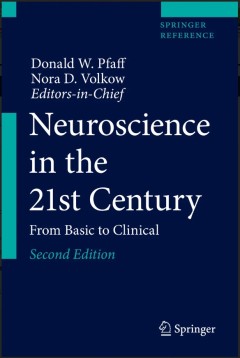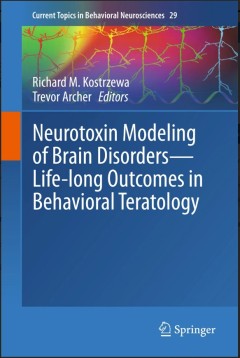Filter by

Behavioral Neurobiology of Huntington's Disease and Parkinson's Disease
Motor dysfunction and cognitive impairment are major symptoms in both Huntington’s Disease (HD) and Parkinson’s Disease (PD). A breakthrough in HD research was the identification of the gene that causes this devastating monogenetic illness. Similarly, several genes were found to cause familial forms of PD. With their identification, a plethora of genetic animal models has been generated and…
- Edition
- -
- ISBN/ISSN
- 978-3-662-46344-4
- Collation
- XIII, 397
- Series Title
- -
- Call Number
- 616.8

Neural Stem Cells in Development, Adulthood and Disease
This comprehensive volume is the first to specifically target developing, adult and diseased neural stem cells. It explores recent advances in the understanding of neural stem cell biology along with strategies that use these cells to tackle neurological diseases and brain aging. Ten inclusive chapters discuss a wide range of topics including neurogenesis, neurodegeneration, demyelinating disea…
- Edition
- 1
- ISBN/ISSN
- 978-1-4939-1907-9
- Collation
- XXI, 202
- Series Title
- Stem Cell Biology and Regenerative Medicine
- Call Number
- -

Neuronal Network Dynamics in 2D and 3D in vitro Neuroengineered Systems
The book presents a new, powerful model of neuronal networks, consisting of a three-dimensional neuronal culture in which 3D neuronal networks are coupled to micro-electrode-arrays (MEAs). It discusses the main advantages of the three-dimensional system compared to its two-dimensional counterpart, and shows that the network dynamics, recorded during both spontaneous and stimulated activity, dif…
- Edition
- 1
- ISBN/ISSN
- 978-3-319-80758-4
- Collation
- XIII
- Series Title
- Springer Theses
- Call Number
- -

Neuroscience in Intercultural Contexts
This breakthrough volume brings together cultural neuroscience and intercultural relations in an expansive presentation. Its selected topics in reasoning, memory, and other key cognitive areas bridge the neuroscience behind culture-related phenomena with the complex social processes involved in seeing the world through the perspective of others. Coverage ranges beyond the familiar paradigms of …
- Edition
- 1
- ISBN/ISSN
- 978-1-4939-5500-8
- Collation
- XXX
- Series Title
- International and Cultural Psychology
- Call Number
- -

Neuroscience in the 21st Century: From Basic to Clinical
Edited and authored by a wealth of international experts in neuroscience and related disciplines, this key new resource aims to offer medical students and graduate researchers around the world a comprehensive introduction and overview of modern neuroscience. Neuroscience research is certain to prove a vital element in combating mental illness in its various incarnations, a strategic battlegr…
- Edition
- 2
- ISBN/ISSN
- -
- Collation
- LV
- Series Title
- -
- Call Number
- -

Neurointervention in the Medical Specialties:A Comprehensive Guide
- Edition
- 1
- ISBN/ISSN
- 978-1-4939-4208-4
- Collation
- XIII, 365
- Series Title
- Current Clinical Neurology
- Call Number
- -
- Edition
- 1
- ISBN/ISSN
- 978-1-4939-4208-4
- Collation
- XIII, 365
- Series Title
- Current Clinical Neurology
- Call Number
- -

Neurosurgical Treatments for Psychiatric Disorders
This book describes contemporary clinical practice in the application of neurosurgical methods to the treatment of psychiatric disorders. It covers diverse topics such as neuroimaging, ethics and a historical review, Gamma Knife and High Frequency Ultrasound ablation, deep brain electrical stimulation and preoperative evaluation and postoperative follow-up. Its application in Obsessive Compulsi…
- Edition
- 1
- ISBN/ISSN
- 978-94-024-0045-8
- Collation
- XIV
- Series Title
- -
- Call Number
- -

Neurotoxin Modeling of Brain Disorders — Life-long Outcomes in Behavioral T…
This book is authored by leading experts who made major discoveries in neuroteratology research focused on modeling human neural developmental disorders. Individual chapters address ADHD (attention-deficit hyperactivity disorder), Lesch-Nyhan disease, psychoses and schizophrenia, autism, and models of Parkinson’s Disease and tardive dyskinesia. The effects of perinatal stress and agonist insu…
- Edition
- 1
- ISBN/ISSN
- 978-3-319-81683-8
- Collation
- VIII
- Series Title
- Current Topics in Behavioral Neurosciences
- Call Number
- -

Neurovascular Events After Subarachnoid Hemorrhage: Towards Experimental and …
This book contains articles presented at the 12th International Conference on Cerebral Vasospasm, held in Lucerne, Switzerland, in July 2013. The included papers represent a balanced cross-section of the enormous progress achieved in basic and clinical research on aneurysmal subarachnoid hemorrhage and its sequelae, including early neurovascular events and delayed cerebral vasospasm. The sectio…
- Edition
- 1
- ISBN/ISSN
- 978-3-319-34806-3
- Collation
- XIV
- Series Title
- Acta Neurochirurgica Supplement
- Call Number
- -

Neuroenhancement: how mental training and meditation can promote epistemic vi…
This book explores how one can bring about changes in the brain through meditation, both through attention-focus training and through compassion training. Recent findings in the natural sciences have confirmed that it is possible for humans to achieve these structural and functional changes through various life-style practices. It is argued that meditation enables us to influence some aspects o…
- Edition
- 1
- ISBN/ISSN
- 978-3-319-23516-5
- Collation
- XI, 110
- Series Title
- SpringerBriefs in Ethics
- Call Number
- -
 Computer Science, Information & General Works
Computer Science, Information & General Works  Philosophy & Psychology
Philosophy & Psychology  Religion
Religion  Social Sciences
Social Sciences  Language
Language  Pure Science
Pure Science  Applied Sciences
Applied Sciences  Art & Recreation
Art & Recreation  Literature
Literature  History & Geography
History & Geography